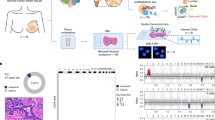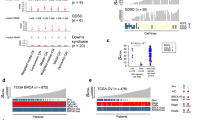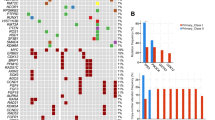Abstract
We have recently discovered that the nuclear matrix protein SAFB is an oestrogen receptor corepressor. Since it has become clear that many steroid receptor cofactors play important roles in breast tumorigenesis, we investigated whether SAFB could also be involved in breast cancer. To address this question, the gene locus was examined for structural alterations in breast cancer tissue. Laser capture microdissection was used for isolating DNA from paired primary breast tumour and normal tissue specimens, and the loss of heterozygosity (LOH) at chromosome 19p13.2–3 was determined by use of microsatellite markers. LOH was detected at the marker D19S216, which colocalizes with the SAFB locus, in specimens from 29 (78.4%) of 37 informative patients. The peak LOH rate occurred at D19S216 near the SAFB locus, with LOH frequencies ranging from 21.6% to 47.2% at other markers. The finding of a very high LOH rate at the marker D19S216 strongly indicates the presence of a breast tumour-suppressor gene locus. While preliminary findings of mutations in SAFB suggest that this indeed may be a promising candidate, other potential candidate genes are located at this locus. © 2001 Cancer Research Campaign
Similar content being viewed by others
Article PDF
Change history
16 November 2011
This paper was modified 12 months after initial publication to switch to Creative Commons licence terms, as noted at publication
References
Anzick SL, Kononen J, Walker RL, Azorsa DO, Tanner MM, Guan XY, Sauter G, Kallioniemi OP, Trent JM and Meltzer PS (1997) AIB1, a steroid receptor coactivator amplified in breast and ovarian cancer. Science 277: 965–968
Bignell GR, Barfoot R, Seal S, Collins N, Warren W and Stratton M (1998) Low frequency of somatic mutations in the LKB1/Peutz-Jeghers Syndrome gene in sporadic breast cancer. Cancer Research 58: 1384–1386
Broman KW, Murray JC, Sheffield VC, White RL and Weber JL (1998) Comprehensive human genetic maps: individual and sex-specific variation in recombination. Am J Hum Genet 63: 861–869
Brown MR, Chuaqui R, Vocke CD, Berchuck A, Middleton LP, Emmert-Buck MR and Kohn EC (1999) Allelic loss on chromosome arm 8p: analysis of sporadic epithelial ovarian tumors. Gynecol Oncol 74: 98–102
Chen JD and Evans RM (1995) A transcriptional co-repressor that interacts with nuclear hormone receptors. Nature 5: 454–457
Chen Y, Chen CF, Riley DJ, Allred DC, Chen PL, Von Hoff D, Osborne CK and Lee W (1995) Aberrant subcellular localization of BRCA1 in breast cancer. Science 270: 789–791
Cook WD and McCaw BJ (2000) Accommodating haploinsufficient tumor suppressor genes in Knudson’s model. Oncogene 19: 3434–3438
Dawson Saunders B and Trapp RG (1994). Basic and Clinical Biostatistics 2nd edition, East Norwalk
Deloukas P, Schuler GD, Gyapay G, Beasley EM, Soderlund C, Rodriguez-Tome P, Hui L, Matise TC, McKusick KB, Beckmann JS, Bentolila S, Bihoreau M, Birren BB, Browne J, Butler A, Castle AB, Chiannilkulchai N, Clee C, Day PJ, Dehejia A, Dibling T, Drouot N, Duprat S, Fizames C and Bentley DR (1998) A physical map of 30,000 human genes. Science 282: 744–746
DuPont BR, Garcia DK, Sullivan TM, Naylor SL and Oesterreich S (1997) Assignment of SAFB encoding Hsp27 ERE-TATA binding protein (HET)/scaffold attachment factor B (SAF-B) to human chromosome 19 band p13. Cytogenet Cell Genet 79: 284–285
Emmert-Buck MR, Bonner RF, Smith PD, Chuaqui RF, Zhuang Z, Goldstein SR, Weiss RA and Liotta LA (1996) Laser capture microdissection [see comments]. Science 274: 998–1001
Esteller M, Silva JM, Dominguez G, Bonilla F, Matias-Guiu X, Lerma E, Bussaglia E, Prat J, Harkes IC, Repasky EA, Gabrielson E, Schutte M, Baylin SB and Herman JG (2000) Promoter hypermethylation and BRCA1 inactivation in sporadic breast and ovarian tumors [In Process Citation]. J Natl Cancer Inst 92: 564–569
Fasman KH, Letovsky SI, Li P, Cottingham RW and Kingsbury DT (1997) The GDB Human Genome Database Anno 1997. Nucleic Acids Res 25: 72–81
Giachino C, Lantelme E, Lanzetti L, Saccone S, Bella Valle G and Migone N (1997) A novel SH3-containing human gene family preferentially expressed in the central nervous system. Genomics 41: 427–434
Glass CK, Rose DW and Rosenfeld MG (1997) Nuclear receptor coactivators. Current Opinion in Cell Biology 2: 222–232
Horlein AJ, Naar AM, Heinzel T, Torchia J, Gloss B, Kurokawa R, Ryan A, Kamei Y, Soderstrom M and Glass CK (1995) Ligand-independent repression by the thyroid hormone receptor mediated by a nuclear receptor co-repressor. Nature 377: 397–404
Kairouz R, Clarke RA, Marr PJ, Watters D, Lavin MF, Kearsley JH and Lee CS (1999) ATM protein synthesis patterns in sporadic breast cancer. Mol Pathol 52: 252–256
Kaiser P, Flick K, Wittenberg C and Reed SI (2000) Regulation of transcription by ubiquitination without proteolysis: Cdc34/SCF(Met30)-mediated inactivation of the transcription factor Met4. Cell 102: 303–314
Lee JW, Choi HS, Gyuris J, Brent R and Moore DD (1995) Two classes of proteins dependent on either the presence or absence of thyroid hormone for interaction with the thyroid hormone receptor. Mol Endocrinol 9: 243–254
Merlo A, Herman JG, Mao L, Lee DJ, Gabrielson E, Burger PC, Baylin SB and Sidransky D (1995) 5′ CpG island methylation is associated with transcriptional silencing of the tumour suppressor p16/CDKN2/MTS1 in human cancers [see comments]. Nat Med 1: 686–692
Montano MM, Ekena K, Delage-Mourroux R, Chang W, Martini P and Katzenellenbogen BS (1999) An estrogen receptor-selective coregulator that potentiates the effectiveness of antiestrogens and represses the activity of estrogens. Proc Natl Acad Sci USA 96: 6947–6952
Morris BJ (1997) Insulin receptor gene in hypertension. Clin Exp Hypertens 19: 551–565
Mueller L, Cordes VC, Bischoff FR and Ponstingl H (1998) Human RanBP3, a group of nuclear RanGTP binding proteins. FEBS Lett 427: 330–336
Nakagawa H, Koyama K, Monden M and Nakamura Y (1999) Analysis of APCL, a brain-specific adenomatous polyposis coli homologue, for mutations and expression in brain tumors. Jpn J Cancer Res 90: 982–986
O’Connell P, Fischbach K, Hilsenbeck S, Mohsin SK, Fuqua SA, Clark GM, Osborne CK and Allred DC (1999) Loss of heterozygosity at D14S62 and metastatic potential of breast cancer. J Natl Cancer Inst 91: 1391–1397
Oesterreich S, Weng C-N, Qiu M, Hilsenbeck SG, Osborne CK and Fuqua SAW (1993) The small heat shock protein hsp27 is correlated with growth and drug resistance in human breast cancer cell lines. Cancer Research 53: 4443–4448
Oesterreich S, Zhang Q, Hopp T, Fuqua SA, Michaelis M, Zhao HH, Davie JR, Osborne CK and Lee AV (2000) Tamoxifen-bound estrogen receptor (ER) strongly interacts with the nuclear matrix protein HET/SAF-B, a novel inhibitor of ER-mediated transactivation [In Process Citation]. Mol Endocrinol 14: 369–381
Osborne CK (1998) Steroid hormone receptors in breast cancer management. Breast Cancer Res Treat 51: 227–238
Pagano M, Tam SW, Theodoras AM, Beer-Romero P, Del Sal G, Chau V, Yew PR, Draetta GF and Rolfe M (1995) Role of the ubiquitin-proteasome pathway in regulating abundance of the cyclin-dependent kinase inhibitor p27 [see comments]. Science 269: 682–685
Sande S and Privalsky ML (1996) Identification of TRACs (T3 receptor-associating cofactors), a family of cofactors that associate with, and modulate the activity of, nuclear hormone receptors. Molecular Endocrinology 10: 813–825
Scheffner M (1998) Ubiquitin, E6-AP, and their role in p53 inactivation. Pharmacol Ther 78: 129–139
Sheikh MS, Hollander MC and Fornance AJ Jr (2000) Role of Gadd45 in apoptosis. Biochem Pharmacol 59: 43–45
Shibata H, Spencer TE, Onate SA, Jenster G, Tsai SY, Tsai MJ and O’Malley BW (1997) Role of co-activators and co-repressors in the mechanism of steroid/thyroid receptor action. Recent Progress in Hormone Research 52: 141–164
Simone NL, Bonner RF, Gillespie JW, Emmert-Buck MR and Liotta JR (1998) Laser-capture microdissection: opening the microscopic frontier to molecular analysis. Trends in Genetics 14: 272–276
Simpson DJ, Hibberts NA, McNicol AM, Clayton RN and Farrell WE (2000) Loss of pRb expression in pituitary adenomas is associated with methylation of the RB1 CpG island. Cancer Res 60: 1211–1216
Talbot CCJ and Cutichia AJ (1999) Human mapping databases. Current Protocols in Human Genetics 1.13.1–1.13.12, John Wiley & Sons, Inc.
Tam SW, Theodoras AM and Pagano M (1997) Kip1 degradation via the ubiquitin-proteasome pathway. Leukemia 11: 363–366
Tamura G, Maesawa C, Suzuki Y, Kashiwaba M, Ishida M, Saito K and Satodate R (1994) Improved detection of loss of heterozygosity at retinoblastoma gene locus in human breast carcinoma. Pathol Int 44: 34–38
Townson SM, Sullivan T, Zhang Q, Clark GM, Osborne CK, Lee AV and Oesterreich S (2000) HET/SAF-B overexpression causes growth arrest and multinuclearity and is associated with aneuploidy in human breast cancer [In Process Citation]. Clin Cancer Res 6: 3788–3796
Wang Z, Cody JD, Leach RJ and O’Connell P (1999) Gene expression patterns in cell lines from patients with 18q-syndrome. Hum Genet 104: 467–475
Warner M, Nilsson S and Gustafsson JA (1999) The estrogen receptor family. Curr Opin Obstet Gynecol 11: 249–254
Wright DK and Manos MM (1990) Sample preparation from paraffin embedded tissues. PCR protocols, Innes MA, Gelfand DH, Sninsky JJ (eds) pp. 153–158, Academic Press: San Diego
Zaika A, Marchenko N and Moll UM (1999) Cytoplasmically “sequestered” wild type p53 protein in resistant to Mdm2-mediated degradation. J Biol Chem 274: 27474–27480
Author information
Authors and Affiliations
Rights and permissions
From twelve months after its original publication, this work is licensed under the Creative Commons Attribution-NonCommercial-Share Alike 3.0 Unported License. To view a copy of this license, visit http://creativecommons.org/licenses/by-nc-sa/3.0/
About this article
Cite this article
Oesterreich, S., Allredl, D., Mohsin, S. et al. High rates of loss of heterozygosity on chromosome 19p13 in human breast cancer. Br J Cancer 84, 493–498 (2001). https://doi.org/10.1054/bjoc.2000.1606
Received:
Revised:
Accepted:
Published:
Issue Date:
DOI: https://doi.org/10.1054/bjoc.2000.1606



